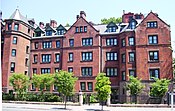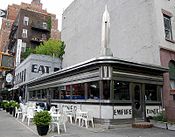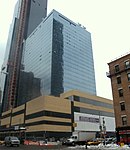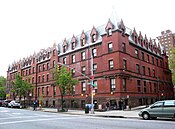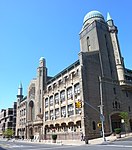Tenth Avenue (Manhattan)
| Amsterdam Avenue (north of 59th Street) | |
 Tenth Avenue at 17th Street, as seen from the High Line | |
| Owner | City of New York |
|---|---|
| Maintained by | NYCDOT |
| Length | 10.5 mi (16.9 km)[1] |
| Location | Manhattan, New York City |
| South end | West Street |
| North end | Fort George Avenue |
| East | Ninth Avenue (below 59th St) Columbus Avenue (above 59th St) |
| West | Eleventh Avenue (below 59th St) West End Avenue (above 59th St) |
| Construction | |
| Commissioned | March 1811 |


Tenth Avenue, known as Amsterdam Avenue between 59th Street and 193rd Street, is a north-south thoroughfare on the West Side of Manhattan in New York City. It carries uptown (northbound) traffic as far as West 110th Street – also known as Cathedral Parkway for the Cathedral Church of St. John the Divine – after which it continues as a two-way street.
Geography
Tenth Avenue begins a block below Gansevoort Street[2] and Eleventh Avenue in the West Village / Meatpacking District. For the southernmost stretch (the four blocks below 14th Street), Tenth Avenue runs southbound. North of 14th Street, Tenth Avenue runs uptown (northbound) for 45 blocks as a one-way street until its intersection with West 59th Street, where it becomes Amsterdam Avenue but continues without interruption. Amsterdam Avenue continues as a one-way street northbound until Cathedral Parkway, where two-way traffic resumes.
As Amsterdam Avenue, the thoroughfare stretches 129 blocks north – narrowing to one lane in each direction as it passes through Yeshiva University's Wilf Campus, between 184th and 186th Streets – before connecting with Fort George Avenue south of Highbridge Park at West 193rd Street.
On the north side of Highbridge Park, unconnected to Amsterdam Avenue on the south side, Tenth Avenue then runs for slightly less than a mile from the northern terminus of the Harlem River Drive at Dyckman Street, to the intersection of West 218th Street and Broadway, where it merges into Broadway.
History
Tenth Avenue runs through the Chelsea and Hell's Kitchen neighborhoods on the west side of the borough, and then as Amsterdam Avenue, through the Upper West Side, Harlem and Washington Heights. Much of these areas were working class or poor for much of the 20th century. The street has long been noted for its commercial traffic, and had grade-level railroad lines through the early 20th century. In the 19th century, when the West Side Line ran along the Avenue, a "Tenth Avenue Cowboy" was paid to ride a horse and warn people of an approaching street running train. The lines were later elevated above street level.
"Amsterdam Avenue" was intended to recall the Dutch roots of Manhattan's earliest colonization in the 17th century. According to Sanna Feirstein's Naming New York:
What is now Amsterdam Avenue was laid out in the 1811 Commissioners' Plan as 10th Avenue and opened from 59th Street to Fort George Avenue in 1816. The name was changed in 1890 in a bid on the part of Upper West Side landowners to confer a measure of old-world cachet to their real estate investments in an area that had yet to catch on. The new avenue name supported the speculators' claim that this section would become "the New City" and a "new, New Amsterdam."[3]
Tenth Avenue and Amsterdam Avenue were converted to carry one-way traffic northbound in two stages. South of its intersection with Broadway the avenue was converted on November 6, 1948.[4][5] The rest to 110th Street was converted on December 6, 1951.[6] Amsterdam Avenue continues to carry two-way traffic north of 110th Street.
During the real estate boom of the late 20th century, Amsterdam Avenue from roughly 59th Street to 96th Street became one of the city's most expensive residential districts.
Transportation
The M11 bus runs northbound along the avenue. North of 72nd Street, the M7 bus also runs northbound on the avenue; north of 110th Street, the M11 bus runs in both directions along Amsterdam Avenue.
As part of the 7 Subway Extension, the 7 and <7> trains are to be extended to 34th Street. An intermediate stop, Tenth Avenue, was originally planned but it was dropped from the official plans in 2008.[7][8][9]
The 1 train serves two stations along Tenth Avenue: 207th Street, and 215th Street.
Notable sites
Gallery
-
The Desmond Tutu Center of the General Theological Seminary at 20th-21st Streets
-
The Empire Diner at 22nd Street
-
The interior of the Holy Name of Jesus Roman Catholic Church at 96th Street
-
The American Youth Hostels building at 103rd Street
-
The Cathedral of St. John the Divine at 110th Street
-
The former NYPD 32nd Precinct building on Amsterdam Avenue at 152nd Stret
-
The Highbridge Play Center at 173rd Street
-
Zysman Hall of Yeshiva University, at 187th Street
In popular culture
- The Rodgers & Hart play On Your Toes (1936) included the comic dance number "Slaughter on Tenth Avenue", performed by Ray Bolger and Tamara Geva. It was later performed on stage, film and television. It has been performed by the New York City Ballet, and was featured in the film version of On Your Toes, danced by Eddie Albert and Vera Zorina. In the biographical musical Words and Music (1948), a "Slaughter on Tenth Avenue" ballet sequence is performed by Gene Kelly and Vera-Ellen.
- Slaughter on Tenth Avenue is also the name of a 1957 crime film and the debut album of Mick Ronson in 1974.
- In Moscow on the Hudson, Robin Williams's character Vladimir Ivanoff lived on 1320 Amsterdam Avenue.
- In How I Met Your Mother, Ted Mosby is said to have lived near the corner of 75th Street and Amsterdam Avenue.
- In Donald E. Westlake's "Dortmunder" series of crime novels the fictional O.J. Bar and Grill, the gang's favorite meeting place, is located on Amsterdam Avenue.
- In the "Asterisk" episode of the American TV drama Suits, Mike Ross mentions renting an apartment "off 10th Avenue", to which his colleague Rachel Zane replies, "Does it come with a bullet-proof vest?".
- Amsterdam Avenue is mentioned in the Joe Jackson song "Stranger Than You", from the album Night and Day II
References
Notes
- ^ "Tenth Avenue / Amserdam Avenuet " (Map). Google Maps. Retrieved December 1, 2015.
- ^ New York City Geographic Information System map
- ^ Feirstein, Sanna (2001). Naming New York: Manhattan Places & How They Got Their Names. New York: NYU Press. p. 169. ISBN 978-0-8147-2712-6. OCLC 558712359. Retrieved August 17, 2012.
- ^ Ingraham, Joseph (7 November 1948). "Traffic Speeded on 9th, 10th Aves. By One-way Plan". The New York Times. Retrieved 28 August 2012.
- ^ "Ninth and Tenth Avenues Are One Way Permanently". The New York Times. 14 May 1949. Retrieved 28 August 2012.
- ^ "Two More Avenues One-way Thursday". The New York Times. 4 December 1951. Retrieved 28 August 2012.
- ^ Chan, Sewell. "M.T.A. Links Rail Extension To Stadium Bid" New York Times (April 2, 2005). Quote: "From its current terminus at Times Square, near 41st Street and Eighth Avenue, the No. 7 would travel west along 41st Street, with a new station at 10th Avenue, and then south along 11th Avenue, with a new terminal at 34th Street."
- ^ Neuman, William. "It’s a Deal: $1.4 Billion to Extend No. 7 Train" New York Times (October 24, 2007). Quote: "Mr. Saul also criticized the project because it omits a proposed station at 41st Street and 10th Avenue..."
- ^ Neuman, William. "No. 7 Extension Won’t Include 10th Ave. Station" New York Times (September 19, 2008). Quote: "Early plans called for the project to also include a station at 10th Avenue and 41st Street. But as cost estimates rose, the station became expendable in the eyes of the city — and it became increasingly clear, by last fall, that financing for the new station was unlikely.
Last fall, the authority signed a $1.14 billion contract with a company to dig the tunnel and excavate the 34th Street station. The contract contained a $450 million option to excavate a cavern for the 10th Avenue station as well. But the authority would have had to agree to the option by last Saturday. The deadline passed with no agreement.
Transit advocates and some public officials have been critical of plans to build the extension without the extra station, saying that it would bypass a growing area in need of subway service."
External links
 Media related to 10th Avenue (Manhattan) at Wikimedia Commons
Media related to 10th Avenue (Manhattan) at Wikimedia Commons

